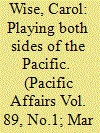|
|
|
Sort Order |
|
|
|
Items / Page
|
|
|
|
|
|
|
| Srl | Item |
| 1 |
ID:
161558


|
|
|
|
|
| Summary/Abstract |
Despite the emergence of a rich literature on the rise of China in Latin America (LAC) since 2000, we are still grappling with this phenomenon. In this article we seek to theorize this expanding South–South relationship from two vantage points. First, from the perspective of China, we argue that, by necessity, the PRC has had to internationalize its development strategy in order to compensate for its serious natural resource deficit, feed the world's largest domestic population, and fuel the soon-to-be largest economy in the world. LAC has been just one slice of China's ‘go out’ strategy. Our second perspective probes the effect of China's entry into the region. Through the lens of development economics, we identify three separate political economy scenarios that have been accentuated within those countries that have the strongest economic ties with China. We rely on measures of institutional performance and macro-economic trends to illustrate the variable effects of China on LAC.
|
|
|
|
|
|
|
|
|
|
|
|
|
|
|
|
| 2 |
ID:
143537


|
|
|
|
|
| Summary/Abstract |
One of the most prominent trends in Latin America in the 2000s has been the proliferation of bilateral free trade agreements (FTAs) across the Pacific basin. Beginning with the path-breaking Chile-Korea FTA in 2004 up to the Costa Rica-Singapore FTA in 2013, the past decade has seen the negotiation of twenty-two cross-Pacific accords. China, too, has jumped on to the cross-Pacific FTA bandwagon, including its negotiation of separate bilateral FTAs with Chile (2006), Peru (2009), and Costa Rica (2011). This paper analyzes the origins, content, and preliminary outcomes of these three China-Latin America FTAs. The findings are threefold: 1) in contrast with other cross-Pacific FTAs, which include at least one developed country, the three FTAs analyzed in this paper constitute “south-south” FTAs; yet, in contrast with other south-south FTAs, these three China-Latin America accords approximate WTO+ standards vis-à-vis the World Trade Organization (WTO) and its new trade agenda (services, investment, and intellectual property rights); 2) although the motives for negotiating these developing- developing country accords varied, on the part of China and the countries themselves, this did not disrupt the march toward WTO+ status; and 3) while all three of these FTAs elude standard theoretical explanations for the negotiation of bilateral FTAs, the three Latin American countries do share similar reform trajectories and institutional affinities, which sheds light on the decision and capacity of each to negotiate a bilateral FTA with China.
|
|
|
|
|
|
|
|
|
|
|
|
|
|
|
|
|
|
|
|
|